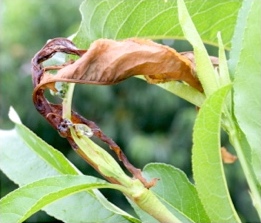A major rain and hail storm occurred at the Rutgers Agricultural Research and Extension Center, Bridgeton during last Thursday evening, 22May. Hail stones the size of marbles fell for about 15 minutes. [Read more…]
Tree Fruit Edition
Seasonal updates on insects, diseases, weeds, maturity dates and cultural practices impacting only tree fruit.
Subscriptions are available via EMAIL and RSS.
Fruit IPM Report May 20, 2014
This week in Fruit IPM
- Peach
- Apple
- Pear
- Blueberry
- Scouting Calendar
- Trap Counts
Pesticide Worker Protection Inspection Warning
The New Jersey Department of Environmental Protection Pesticide Control Program (NJDEP) has announced that federal agricultural Worker Protection Standard (WPS) compliance farm inspections will be conducted mid-May through July. Be a prepared agricultural employer. Take the necessary actions this week to make sure your farm is in compliance to avoid citations.
Two outstanding farm employer resources on agricultural WPS compliance are:
1. EPA Ag Employer Quick Reference Guide (2005)
2. EPA website How to Comply with the Worker Protection Standard for Agricultural Pesticides: What Employers Need to Know
These are inspections by the US EPA, although NJDEP inspectors may accompany them. Approximately 20 to 30 inspections are slated to be conducted any time from May through July.
Fruit IPM Report May 14, 2014
This week in Fruit IPM
Brown Marmorated Stink Bug (BMSB):
Emergence from overwintering sites has started!
Both male and females are being found in pheromone traps and blacklight traps throughout the state. Any insecticides or insecticide mixes that are used for oriental fruit moth, plum curculio, codling moth or other pests should now include materials effective for BMSB.
- Peach
- Apple
- Blueberry
- Scouting Calendar
- Trap Counts
Copper Bactericides for Peach Bacterial Spot Management
Fruit Infection
Effective management of bacterial spot on peach and nectarine necessitates application of bactericides during the post-bloom cover spray period. Early fruit infections during the first two to three weeks of this period generally result in large, deeply pitted blackened lesions that often ooze with sap. Later season fruit lesions are less pitted and much more shallow, but can be numerous, particularly on highly susceptible cultivars. Either way, considerable yield loss can occur on susceptible cultivars when the environment is favorable and/or inoculum levels are high. [Read more…]
Fruit IPM Report May 6, 2014
This week in Fruit IPM
- Peach
- Apple
- Pear
- Blueberry
- Scouting Calendar
- Trap Counts

